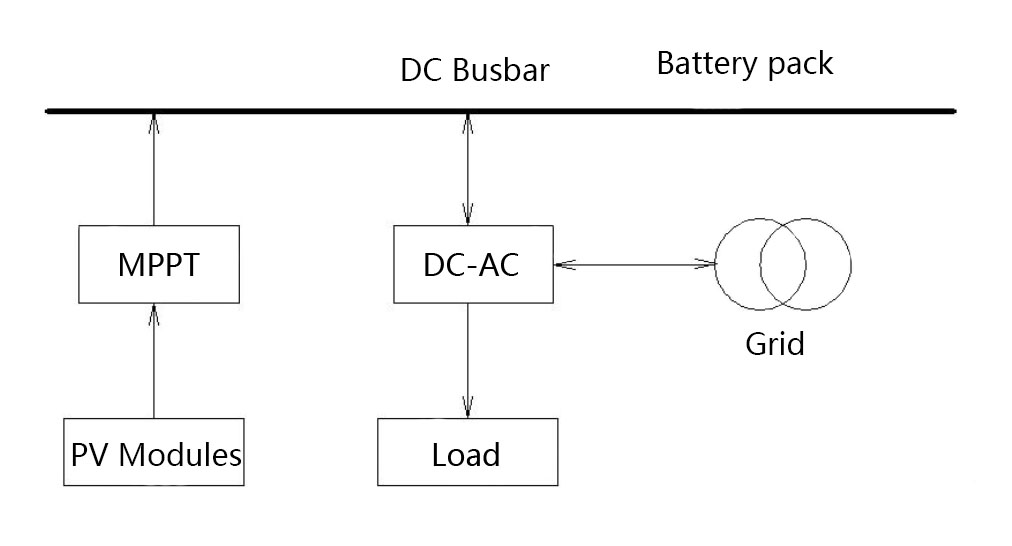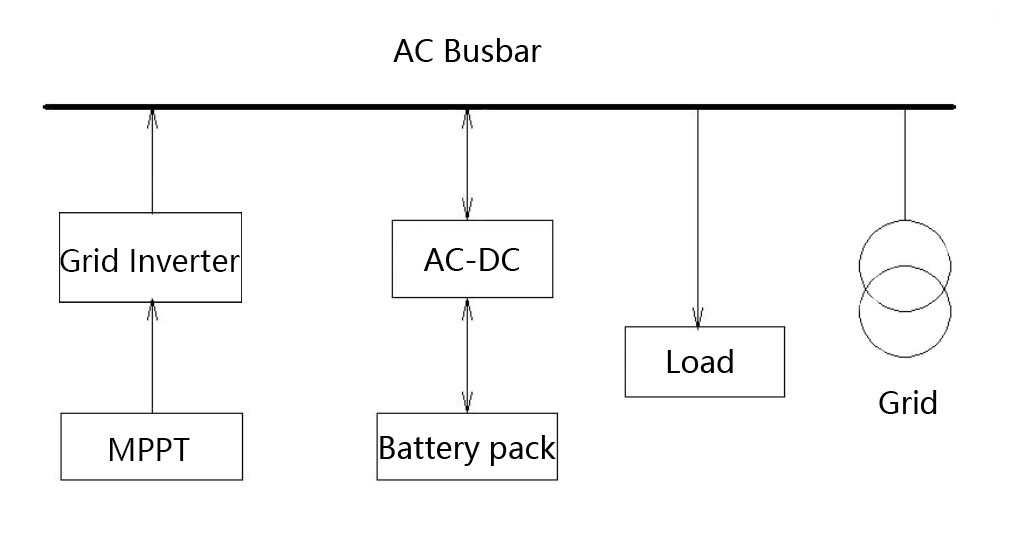Basic principles
1. DC coupling
Concept: DC coupling refers to how the energy storage and power systems are connected through direct current (DC) voltage. In this case, current can only flow in one direction, from positive to negative.
As shown in the figure below, the DC power emitted by the photovoltaic modules is stored in the battery bank through the controller. The grid can also charge the battery through the bidirectional DC-AC converter. The energy collection point is at the DC battery terminal.

The basic principle of this technology is to convert DC power into the charging or discharging current of the battery through a DC-AC converter to achieve the storage and release of electrical energy. In addition, energy storage DC coupling technology can also convert DC power into AC power supply through an inverter to achieve conversion of DC and AC power.
The working principle of DC coupling: When the photovoltaic system is running, the battery is charged through the MPPT controller; when the electrical load has demand, the battery will release power, and the size of the current is determined by the load. The energy storage system is connected to the grid, and if the load is small and the battery is fully charged, the photovoltaic system can supply power to the grid. When the load power is greater than the photovoltaic power generation, the grid and photovoltaics can supply power to the load at the same time. Because photovoltaic power generation and load power consumption are not stable, batteries must be relied upon to balance system energy.
2. AC coupling
Concept: AC coupling refers to how the energy storage and power systems are connected through alternating current (AC) voltage. In this case, current can flow in both directions, making the system more flexible.
As shown in the figure below, the DC power emitted by the photovoltaic modules is converted into AC power through the inverter and is directly supplied to the load or sent to the power grid. The power grid can also charge the battery through a bidirectional DC-AC bidirectional converter. The convergence point of energy is at the communication end.

The working principle of AC coupling includes a photovoltaic power supply system and a battery power supply system. The photovoltaic system consists of a photovoltaic array and a grid-connected inverter; the battery system consists of a battery pack and a bidirectional inverter. These two systems can operate independently without interfering with each other, or they can be separated from the large power grid to form a microgrid system. The basic principle of this technology is to convert AC power into DC power for storage and release through an AC-DC converter. In addition, energy storage AC coupling technology can also convert DC power into AC power supply through an inverter to achieve conversion of DC and AC power.
Both DC coupling and AC coupling are currently mature solutions, each with its own advantages and disadvantages. Choose the most appropriate solution according to different applications. The following is a comparison of the two solutions.
Difference
- Cost Comparison
DC coupling includes a controller, bidirectional inverter and switch. AC coupling includes a grid-connected inverter, bidirectional inverter and distribution cabinet. From a cost perspective, the controller is cheaper than the grid-connected inverter. Switching Switches are also cheaper than power distribution cabinets. The DC coupling solution can also be made into an all-in-one control inverter, which can save equipment costs and installation costs. Therefore, the cost of the DC coupling solution is lower than that of the AC coupling solution.
- Technical characteristics
There are certain differences in technical characteristics between energy storage DC coupling technology and energy storage AC coupling technology. The characteristics of energy storage DC coupling technology are the same input and output voltage, variable current, low energy consumption, and high-efficiency energy conversion. Energy storage AC coupling technology is characterized by different input and output voltages, unstable current, and energy loss, but it has better adaptability and flexibility and can meet the needs of different grid loads.
- Efficiency comparison
From the perspective of photovoltaic utilization efficiency, both solutions have their own characteristics. If the user loads more during the day and less at night, it is better to use AC coupling. The photovoltaic modules directly supply power to the load through the grid-connected inverter, and the efficiency can reach 96 %above. If the user has less load during the day and more at night, and the photovoltaic power generated during the day needs to be stored for use at night, it is better to use DC coupling. The photovoltaic module stores the electricity in the battery through the controller, and the efficiency can reach more than 95%. If it is AC coupling, , photovoltaics must first be converted into alternating current through an inverter and then converted into direct current through a bidirectional converter, and the efficiency will drop to about 90%.
- Application fields
Energy storage DC coupling technology is mainly suitable for low-power applications in energy storage scenarios, such as electric vehicles, home photovoltaics and other fields. Energy storage AC coupling technology is mainly suitable for medium and high-power applications in energy storage scenarios, such as industrial power, grid energy storage and other fields.
- Advantages and Disadvantages
There are also certain differences in the advantages and disadvantages of energy storage DC coupling technology and energy storage AC coupling technology. Energy storage DC coupling technology has the advantages of high battery utilization, good system stability, small size, and low noise, but the system is complex and costly; energy storage AC coupling technology has the advantages of flexible design, wide application range, and low cost. However, there are shortcomings, such as inverter loss, capacity limitation, and low power density.
- Applicability comparison
In a DC-coupled system, the controller, battery and inverter are connected in series, and the connection is tight, but the flexibility is poor. In the AC coupling system, the grid-connected inverter, battery and bidirectional converter are parallel, the connection is not tight, and the flexibility is good. For example, if you need to install an energy storage system in an already installed photovoltaic system, it is better to use AC coupling. You only need to install a battery and a bidirectional converter. It will not affect the original photovoltaic system, and the energy storage system will In principle, the design is not directly related to the photovoltaic system and can be determined according to needs. If it is a newly installed off-grid system, photovoltaics, batteries, and inverters must be designed according to the user’s load power and electricity consumption, and a DC coupling system is more suitable. However, the power of DC-coupled systems is relatively small, generally below 500kW. No matter how large the system is, it is easier to control with AC coupling.
Summary
Energy storage DC coupling technology and energy storage AC coupling technology are each suitable for different scenarios and can be selected according to specific needs. Generally speaking, energy storage DC coupling technology is suitable for low-power, high-precision, and high-efficiency fields. In contrast, energy storage AC coupling technology is suitable for high-power, low-cost, and high-flexibility fields. As technology continues to develop, the application scope of energy storage technology will continue to expand.

